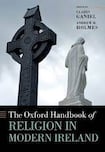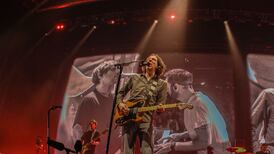
The island of Ireland has had a strained relationship with religion for quite some time and this is certainly true during the period covered in this collection, which attempts to chart its imprint in the years 1800-2023, which the editors take, for the purposes of this book, as representing “modern Ireland”. The 32 essays are divided into three sections which examine religion, politics and society during specific time spans: the first, 1800-1922, covers the period from the Act of Union up to Partition; the second, 1922-1968, ends with the outbreak of the “Troubles” in Northern Ireland, which, for some, was an inevitable consequence of partition; and the last one from the 1960s up to the present day. The project is thus ambitious in terms of the timeline and the decision to cover the two jurisdictions within the country.
Religion in Ireland has always been closely aligned to politics and issues of identity, with some identifying as Catholic/green/nationalist, while others prefer the Protestant/orange/loyalist brand. Of course, such labels are often arbitrary and do not capture the reality for huge swathes of people within the Christian tradition. Then there are others, and the number is increasing all the time, who classify themselves as being “lapsed” members of whichever religious grouping to which they once belonged. You can sense already just how difficult it is to track the influence of religion on any culture at any time, let alone capture how it has played out in a country with such a long history of religious strife as Ireland.
The editors have assembled a fine cast of contributors, which includes instantly recognisable names such as Guy Beiner, Ian D’Alton, Marianne Elliott, Louise Fuller, Gladys Ganiel, Myrtle Hill, Tom Inglis, Dáithí Ó Corráin, Robert J. Savage and Graham Walker. The essays concentrate largely on Roman Catholicism and the main variants of Protestantism, which between them constitute by far the largest religious denominations in the country. It struck me as strange, however, that a full chapter is devoted to Paganism, albeit a fascinating topic, whereas Islam, the third largest religion in Ireland, is confined to a sub-section dealing with minority religions and immigration. Similarly, the substantial role played by the Jewish community or the Huguenots in key areas of Irish life might have merited more attention than they have received. Finally, a strong case could be made for a companion piece to Norman Vance’s survey of religion and literature 1798-1923, covering the past century whose literature is even more strongly marked by religious concerns.
On the plus side, it is good to see contributions dealing with science, education, broadcasting and the law, which unearth some fascinating insights. The decision to conclude the book with a chapter on the rise of those who place themselves in “No Religion” category is significant. In it, Hugh Turpin notes the important disaffiliation on the part of many Catholics in particular, who felt they had an obligation to opt out in the wake of the clerical abuse scandals, “because to remain Catholic, even if disengaged, is to offer succour to a morally reprehensible and repressive institution”.
An Irish doctor on why she believes autism, ADHD and depression are being overdiagnosed
Ireland’s remote islands: Only 29 apply for €84,000 grant aimed at attracting residents
Excuse My French restaurant review: An experience simply unlike anything else in Dublin
10 of the best new shows to watch in April: including Netflix medical drama and two AppleTV+ releases
The editors contend that contemporary perceptions of religion are strongly influenced by the significantly sectarian conflict that ravaged during the Troubles and the rapid secularization that took place in the Republic from the 1960s to the present day. For centuries, issues of culture and identity were crucial in determining to which “tribe” a person declared allegiance, even if the lines were often a lot more blurred than they would appear at first sight. For example, the United Irishmen republican movement was founded by Protestants, namely Wolfe Tone, Robert Emmet, Henry Joy McCracken and James Napper Tandy. Their espousal of violent rebellion to achieve their objectives was in stark contrast to Daniel O’Connell’s absolute commitment to entirely peaceful means, an approach that led to Catholic Emancipation being granted in 1829. This was seen by his supporters as the end of the hated Penal Laws and it also meant that Catholics could henceforth sit in Parliament at Westminster. Significantly, Catholic Emancipation signalled the end of a long-held attempt to set up a Protestant state church and would ultimately lead to the disestablishment of the Church of Ireland in 1871.
The Eucharistic Congress of 1932 provided an ideal opportunity to showcase on the world stage the commitment of Ireland to the Catholic faith
The nineteenth-century was also characterised by political and agrarian unrest. The tithes exacted from all landholders, regardless of religious allegiance, to support the Church of Ireland were a particular bugbear for Catholics. Another source of dissent during the Famine was “souperism”, the expression used to describe the provision of food to a starving population in return for conversion to Protestantism – the extent to which this actually happened is open to doubt. On the other hand, the Devotional Revolution, which was characterised by a massive church-building campaign spearheaded by Cardinal Paul Cullen (1803-1878), was an attempt by Catholic leaders to escape from the shadows of Anglicanism. Louise Fuller considers it logical that, having suffered such hardship under the Penal Laws, the Catholic Church should have viewed the emergence of the Free State in 1922 as an opportunity to flex its muscles: “Symbols of Catholicism were ubiquitous in homes and public places – the Sacred Heart picture, the papal marriage blessing, the crucifix, statues of the Blessed Virgin, the Infant of Prague, St Joseph, and others”.
It was undoubtedly a help that the newly established state was more than happy to allow the church have free rein in the two key areas of education and health. The Eucharistic Congress of 1932 provided an ideal opportunity to showcase on the world stage the commitment of Ireland to the Catholic faith, with clerics and politicians prominent at the mass in the Phoenix Park that attracted in excess of one million people, approximately 100,000 of whom travelled down from the North. Vocations to the priesthood and the religious life were booming and attendance at mass and the sacraments extremely high. But change would come in the 1960s, with the arrival of economic prosperity, educational reform, the advent of television, increased foreign travel, and the impact of Vatican II, all of which led to a less docile acceptance of Catholic teaching, particularly in the realm of sexuality. The breakout of the Troubles in the North diverted much attention to dealing with sectarian violence, political agitation, hunger strikes and social unrest in that part of the island.
The liberal crusade initiated by Fine Gael then-taoiseach Garret FitzGerald in the 1980s put him on a collision course with the Catholic Church hierarchy that resented any attempt to undermine their “special position” as enshrined in the 1937 Constitution. Although unsuccessful in the divorce and abortion referenda, FitzGerald’s pioneering work would ultimately lead to the decriminalization of homosexuality among consenting adults (1993), the removal of the ban on divorce (1995), the introduction of same-sex marriage (2015) and the legalization of abortion (2018), making Ireland’s social legislation one of the most liberal in the western world.
The clerical abuse scandals along with the findings of further inquiries carried out on the Industrial Schools, Magdalene Laundries and Mother and Baby Homes led to further disenchantment with the Catholic Church
The visit of Pope John Paul II in 1979, viewed by some as the apogee of Irish Catholicism, had in fact been prompted by the realisation that Ireland was following the example of other European countries in its embrace of secularism. The “moral monopoly” enjoyed so long by the Catholic Church according to Tom Inglis was based on the cultural capital associated with being perceived to be a “good” Catholic. Inglis identifies large swathes of “cultural Catholics” in Ireland today who identify with being Catholic “while only partially believing and with no sense of belonging”.
The clerical abuse scandals, which led to the establishment of commissions of inquiry that revealed deliberate cover-ups by the church hierarchy, along with the findings of further inquiries carried out on the Industrial Schools, Magdalene Laundries and Mother and Baby Homes, all run by religious orders with the support of the state, led to further disenchantment with the Catholic Church. The Protestant churches are struggling with similar issues, though to a lesser degree, but no matter what metrics are applied, the situation is far from positive for religion in Ireland.
Charles Taylor, in A Secular Age, argues that the main change brought about by secularism is the one “which takes us from a society in which it was virtually impossible not to believe in God, to one in which faith, even for the staunchest believer, is one human possibility among others”. This, it seems to me, is a good summation of what has happened in Ireland over the past two and a quarter centuries, as the gradual move away from formal religious practice has resulted, not in the death of religion, more in a readjustment of the role that it plays in people’s public and private lives. The Oxford Handbook of Religion in Ireland is a vital step in understanding the consequences of this process.
Eamon Maher is director of the National Centre for Franco-Irish Studies in TU Dublin and co-editor, with Eugene O’Brien, of Tracing the Cultural Legacy of Irish Catholicism: From Galway to Cloyne and Beyond (Manchester University Press).
Recommended reading
Religion, Landscape and Settlement in Ireland: From Patrick to Present by Kevin Whelan (Four Courts Press, 2019). This book adopts a 32-county approach and covers the period from Saint Patrick’s arrival in 432 up until 2018. Whelan expertly points out the innumerable links between religion and Ireland’s cultural heritage, links that can be seen in literature, folklore and the built environment.
Protestant and Irish: The minority’s search for place in independent Ireland, edited by Ian d’Alton and Ida Milne (Cork University Press, 2019). An invaluable collection which gives voice to the experiences of a wide cross section of southern Protestants – including clerics, revolutionaries, members of the working class, rural women, academics – to highlight the diverse nature of their views and their fluid and uncertain status in a 26-county Ireland after independence.
The Catholics of Ulster: A History by Marianne Elliott (Allen Lane, 2000). An absorbing narrative of what is distinctive about Ulster Catholicism, its links to nationalism and the gradual development of what Elliott terms Northern Catholics’ “cult of grievance”. While it is clearly an academic study, Elliott’s style is engaging and generally easy to read.













